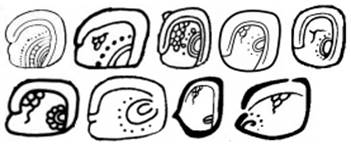![]()
![]()
![]()
![]()
![]()
K&H.p86 TOK.p12.r5.c3 BMM9.p12.r6.c4 25EMC.pdfp47.#5.1 = JM.p237.#1 JM.p238.#3
TUN TUUN TUN TUN TUN TUN:ni

![]()
K&L.p7.#3 [25EMC.pdfp47.#5.3 = K&L.p7.#3.1] 25EMC.pdfp47.#5.2
TUN
![]()
![]()
Greene Martin-AMP.p398.r1.c3
PAL Tablet of the Slaves B3
<11:tu:TUUN>.<1:WINIKHAAB> <bu:ku>.<TUUN:ni:AJAW>
![]()
![]()
![]()
![]()
K&L.p7.#3 TOK.p29.r2.c4 BMM9.p15.r1.c2 25EMC.pdfp47.#5.5
TUN TUUN TUN TUN
![]()
25EMC.pdfp47.#5.4 = JM.p237.#2
TUN TUN
· Variants (2):
o A. Boulder – features:
§ Asymmetric cave with one or both of “stalactite” and “pool of water” (but must have one of the two).
§ There is a sub-variant of the boulder-outline variant of TUUN where there are only a very few dots in the stalactite (canonically, three), and each of the dots has a tiny dot / single point in the middle.
o B. Snake head – features:
§ Infixed one or both of “stalactite” and “pool of water” (but must have one of the two).
§ The boulder variant of TUUN very often has an end phonetic complement of ni, to help distinguish it from ku. However, the (snake-)head variant doesn’t need this.
· TUUN (=ku) has elements in common with the “cave” variant of WITZ, namely a “pool of water” and a “stalactite” – the distinguishing characteristic is that WITZ has a large proportion (sometimes all) of the inside in bold, with “curly” arcs protruding into the inside of the cave, in contrast to TUUN / ku which has the plainer outer outline of just a cave. The “stalactite” is also sometimes informally referred to as the “bunch of grapes”.
· The traditional interpretation of the two elements inside the logogram is a “stalactite” (top left) and a “pool of water” (bottom right). However, Erik Boot told Dorota Bojkowska that they indicate the cracks in the stone when the stone is broken. It is currently unclear to what extent Boot’s interpretation has been accepted by other epigraphers. Mark Van Stone, in his short clip explaining QRG Stela C (VanStone-MC-A2012.t0:07:36-08:01), still uses the traditional explanation. This video was uploaded in 2011, so is at least that old (perhaps older). So his use of that interpretation is not an indication that opinions haven’t changed.
· PAL Tablet of the Slaves B3:
o Has an initial phonetic complement tu, which is much less common than end phonetic complement of ni.
o Is the third place of the DN (=the year, after the K’IN and WINIK/WINAL place) with a reading tuun, which is much less common than with the reading haab.